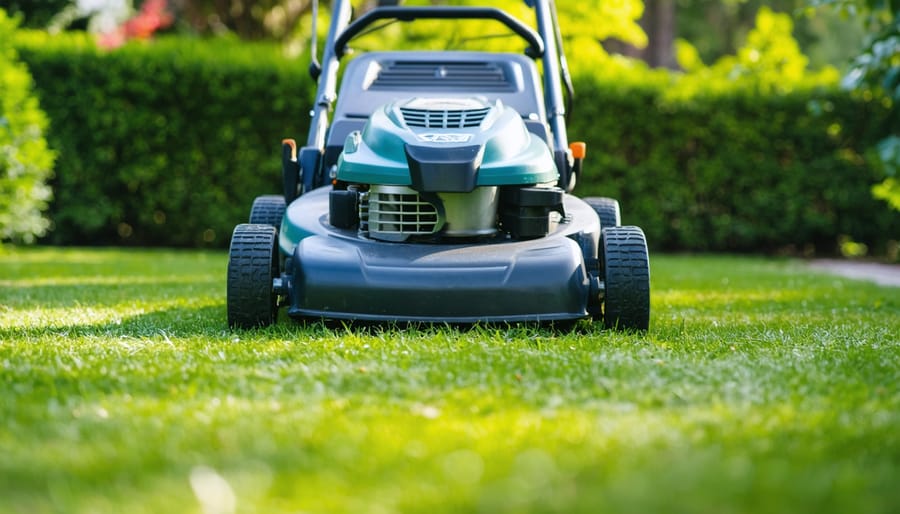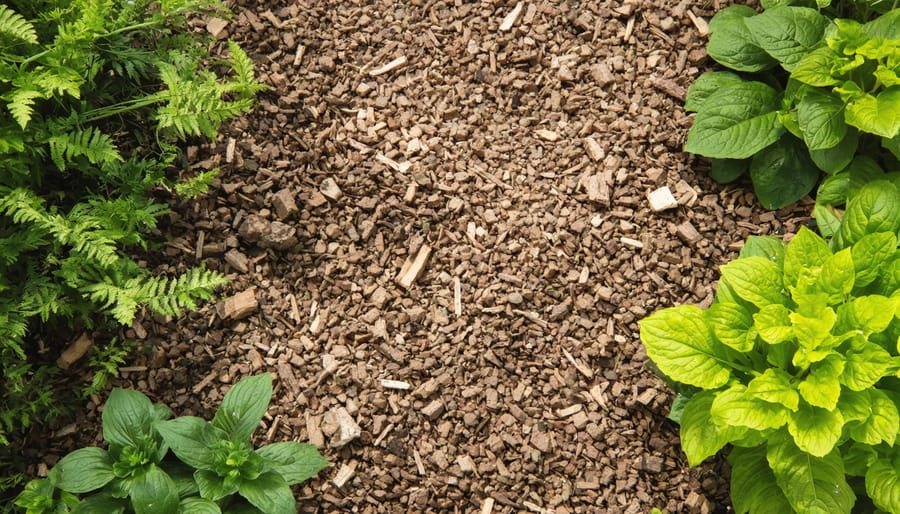Dilute dog urine spots within 8 hours using a thorough water flush to prevent nitrogen burn and maintain your lawn’s vibrant appearance. Train dogs to urinate in a designated area using positive reinforcement and natural barriers like decorative rocks or mulch zones. Supplement affected grass areas with gypsum or specialized enzyme treatments that neutralize urine’s harmful effects while maintaining a healthy lawn. Choose dog-resistant grass varieties like tall fescue or perennial ryegrass that better withstand pet traffic and urine exposure.
The relationship between our furry friends and our pristine lawns doesn’t have to be contentious. Dog urine damage affects countless homeowners, but understanding the science behind it reveals simple, effective solutions. High nitrogen concentration in dog urine creates those distinctive brown patches, yet with proper management techniques, you can protect your lawn while keeping your four-legged family members happy and healthy. The key lies in prompt action, consistent maintenance, and smart landscaping choices that work harmoniously with your pet’s natural behaviors.
Understanding Dog Urine Damage
The Chemistry Behind Brown Spots
Dog urine damage to lawns isn’t just a matter of wetness – it’s actually a complex chemical reaction. When your dog urinates, they release a concentrated dose of nitrogen-rich compounds, primarily urea. While nitrogen is essential for plant growth (it’s a key component in fertilizers), too much of it can be devastating for grass.
Think of it like making coffee – a little bit gives you energy, but drinking an entire pot might make you jittery. Similarly, the nitrogen concentration in dog urine can be up to 10 times stronger than what your grass can handle. When this concentrated solution hits your lawn, it essentially “burns” the grass through a process called nitrogen toxicity.
Adding to this chemical cocktail is the pH level of dog urine, which typically ranges from 6.0 to 6.5. While this might seem only slightly acidic, when combined with the high nitrogen content, it creates the perfect conditions for those characteristic brown spots. Female dogs tend to cause more damage because they typically release their entire bladder in one spot, rather than marking multiple areas like males do.
Identifying Urine Damage vs. Other Lawn Problems
Distinguishing between dog urine damage and other lawn problems can be tricky, but there are several telltale signs to look for. Dog urine damage typically appears as circular patches that are brown in the center with a darker green ring around the edges. This distinctive “bull’s-eye” pattern occurs because nitrogen concentrations are highest in the center, burning the grass, while diluted nitrogen at the edges actually acts as a fertilizer.
Other common lawn issues present differently. Fungal diseases usually create irregular patterns or patches without the characteristic green ring. Insect damage often appears as uniform brown areas with visible soil disruption, while fertilizer burns create sharply defined dead patches without any green borders.
The location of the damage can also be revealing. Urine spots are usually random and scattered, while other problems tend to affect larger, more continuous areas. Additionally, urine damage typically appears within 24-48 hours after exposure, while fungal or insect problems develop more gradually.
If you’re unsure, check for additional clues: urine spots are most common along paths your dog frequently travels or near favorite marking spots. They’re also more noticeable during dry periods when the grass isn’t getting enough water to dilute the nitrogen naturally.
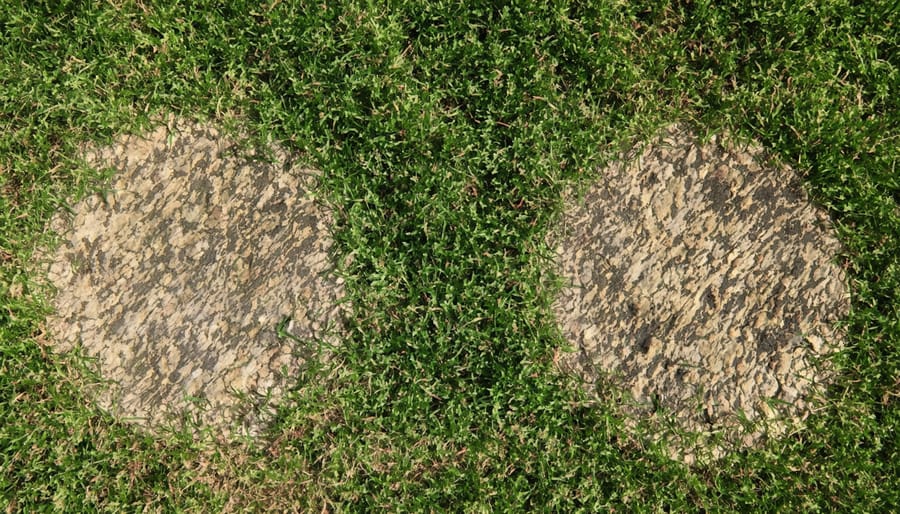
Prevention Strategies
Designated Potty Areas
Creating a designated potty area for your dog is an effective way to protect your lawn while ensuring your pet has a comfortable space to do their business. The key is to choose a spot that can integrate naturally with landscape design while being easily accessible for your furry friend.
Start by selecting a corner of your yard that’s somewhat private but not too far from your home. Consider using materials like pea gravel, mulch, or artificial turf to create a defined space. These surfaces are easy to clean, provide good drainage, and won’t be damaged by dog urine. Border the area with pavers or decorative stones to create clear boundaries.
Training your dog to use this designated spot is crucial for success. Begin by leading them to the area on a leash during their usual potty times. Use positive reinforcement with treats and praise when they use the designated spot correctly. Consistency is key – maintain this routine for at least a few weeks until it becomes a habit.
Keep the area appealing by regularly cleaning it and replacing materials as needed. Installing a small post or decorative fire hydrant can help attract your dog to the spot. Consider adding some hardy, urine-resistant plants around the perimeter to maintain aesthetic appeal while serving a practical purpose.
Remember to place a water source nearby, as encouraging your dog to drink more water can help dilute their urine and reduce lawn damage overall.
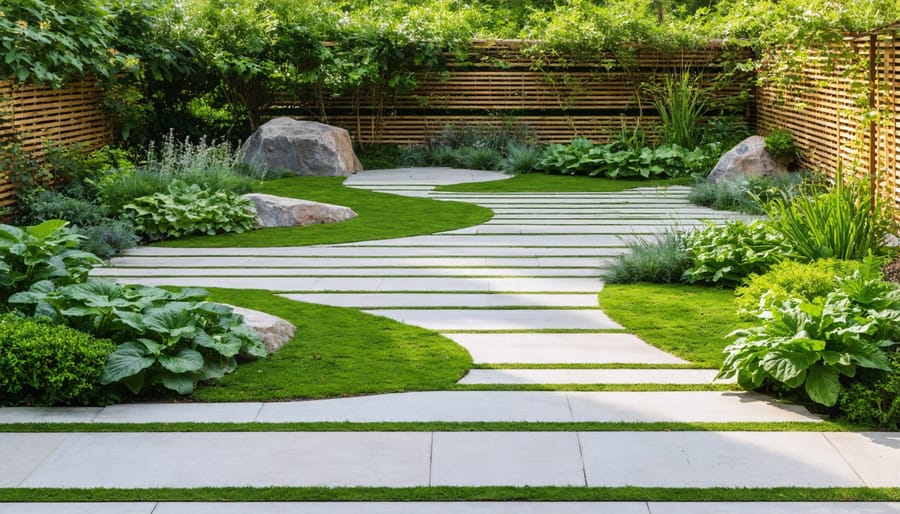
Lawn Treatment Solutions
Several effective lawn treatment solutions can help protect your grass from dog urine damage while keeping your yard pet-friendly. One popular natural remedy is gypsum, which helps neutralize the soil and promotes healthy grass growth. Simply sprinkle it over affected areas monthly during the growing season.
Consider using specialized lawn protection products like Dog Rocks, which are natural stones you add to your pet’s water bowl to help reduce nitrogen content in their urine. Enzyme-based spray treatments can also break down urine compounds and minimize grass damage when applied regularly to affected areas.
For an eco-friendly approach, try creating a DIY protective spray using one part apple cider vinegar to eight parts water. Spray this solution on vulnerable grass areas weekly to help maintain soil pH balance. Beneficial soil microbes can also be introduced through commercial products or compost tea to help neutralize urine effects naturally.
Remember to water affected areas thoroughly immediately after your dog urinates – this simple solution dilutes the urine and reduces its impact on your lawn. For extensive protection, consider applying organic soil conditioners that contain humic acid and beneficial bacteria, which help maintain soil health and grass resilience.
When selecting treatments, always choose pet-safe options that won’t harm your four-legged friend while protecting your lawn’s appearance and health.
Training Tips
Training your dog to use a designated bathroom area is one of the most effective ways to protect your lawn from urine damage. Start by choosing a specific spot in your yard – ideally a less visible area with materials like gravel, mulch, or artificial turf. Lead your dog to this spot every time they need to relieve themselves, using consistent commands like “go potty” or “bathroom.”
Positive reinforcement is key to successful training. Reward your pet immediately after they use the designated area with treats and enthusiastic praise. This creates a strong association between the correct behavior and rewards. Be patient, as it may take several weeks for your dog to fully understand and comply with the new routine.
Consider establishing a regular schedule for bathroom breaks. Most dogs need to relieve themselves first thing in the morning, after meals, and before bedtime. Taking them to the designated spot at these predictable times helps reinforce the habit.
If your dog starts to use an undesired area, interrupt them gently and guide them to the correct spot. Avoid punishment, as this can create anxiety around bathroom habits. Instead, clean any accidents thoroughly to remove scent markers that might attract them back to the same spot.
For multiple-dog households, watching one dog use the designated area often encourages others to follow suit, making training easier over time.
Repair and Restoration
Immediate Response Methods
When your dog has just urinated on your lawn, quick action can significantly reduce the potential damage. First, immediately water the affected area thoroughly with a garden hose or watering can. This simple step dilutes the urine and helps distribute the nitrogen more evenly, preventing the concentrated “burn” effect that creates those unsightly brown patches.
Keep a dedicated watering can or spray bottle near your door for convenience. Aim to saturate the area with at least 2-3 times the amount of liquid as the original urine spot. If you can’t water immediately, try to do so within 8 hours for the best results.
For extra protection, consider keeping a natural enzyme cleaner specifically designed for lawn use nearby. These products break down the uric acid in dog urine and can be applied right after watering. Just spray the affected area according to the product instructions.
Some gardeners swear by sprinkling gypsum on the spot after watering. This natural mineral helps neutralize the soil and can prevent nitrogen buildup. Apply about a handful to each affected area, but use this method sparingly as too much gypsum can affect soil structure.
Remember to mark problem areas with small garden stakes or flags if you notice repeated urination spots. This helps you monitor these zones and take preventive measures in the future. It’s also helpful to note which areas your dog favors, as this information can guide your long-term lawn protection strategy.
While immediate response is crucial, consistency is key. Make these quick treatments part of your regular routine whenever your dog uses the lawn.
Long-term Restoration Techniques
When your lawn shows signs of dog urine damage, don’t worry – there are several effective restoration techniques to bring it back to life. Start by thoroughly removing any dead grass and loosening the soil in the affected areas. This initial step is crucial as it helps break up any salt buildup from the urine and prepares the soil for new growth.
Next, apply a layer of quality topsoil mixed with organic matter to improve soil structure and provide essential nutrients. This mixture helps neutralize the soil pH and creates an optimal environment for new grass growth. Following proper lawn watering techniques is essential during this restoration period to ensure the new grass establishes strong roots.
For reseeding, choose grass varieties that are more resistant to dog urine, such as perennial ryegrass or fescue blends. Spread the seeds evenly and keep the area consistently moist until germination occurs. Consider using a light layer of straw or seed blanket to protect the seeds and retain moisture.
To prevent future damage, establish designated bathroom areas for your dog using gravel or artificial turf. Train your pet to use these spots consistently, and reward them for doing so. Additionally, maintain a regular schedule of core aeration and overseeding to keep your lawn resilient and better able to withstand occasional urine spots.
For long-term success, implement a balanced fertilization program that doesn’t over-apply nitrogen, as this can make urine damage worse. Consider using gypsum or other soil amendments periodically to help flush accumulated salts from the soil profile, ensuring your lawn stays healthy and resistant to future damage.
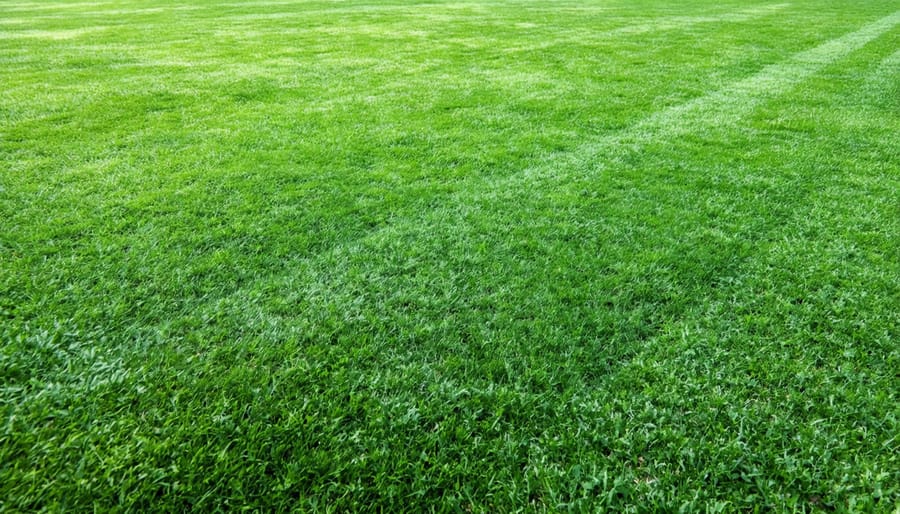
Maintaining a beautiful lawn while keeping our four-legged friends happy doesn’t have to be a constant struggle. By implementing the strategies we’ve discussed, you can create a harmonious balance between your dog’s needs and your lawn care goals. Remember that prevention is always better than cure – establishing designated bathroom areas, providing adequate hydration, and maintaining proper lawn care practices are your first line of defense.
Don’t forget that a healthy, well-maintained lawn is naturally more resistant to urine damage. Regular watering, appropriate fertilization, and maintaining optimal grass height all contribute to your lawn’s resilience. The key is consistency in both your lawn care routine and your pet training efforts.
If you’re still experiencing challenges, consider experimenting with different solutions we’ve covered, from training techniques to lawn treatments. Every dog and every lawn is unique, so what works best for you might require some trial and error. The good news is that with patience and the right approach, you can enjoy both a lush, green lawn and the companionship of your beloved pet.
Remember that sustainable practices not only benefit your lawn but also create a safer environment for your pets. By choosing eco-friendly products and maintaining natural solutions, you’re investing in the long-term health of both your lawn and your furry family members. With these strategies in place, you can look forward to many happy years of outdoor enjoyment with your pet while maintaining the lawn of your dreams.

